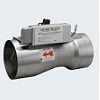Raising the level of correct measurement technology in a new environment
In pursuit of the measurement quality expected from the azbil Group the calibration laboratory was moved to a new laboratory building, introducing in-house technology to create a world-class calibration environment.
Measurement is essential for maintaining and improving productivity in factories, ensuring quality, and achieving comfort through building air conditioning. Azbil has relocated its calibration lab, which maintains the accuracy of various measuring instruments, to a new laboratory building built within the Fujisawa Technology Center, and has created an ideal calibration environment by making full use of Azbil’s advanced air conditioning technology. This is expected to further improve the level of the best calibration technology in Japan.
- Outstanding calibration technology that ensures the accuracy of various measuring instruments
- Overcoming the challenges of the old environment by relocating to a new laboratory building
- Aiming to create an ideal calibration environment by making full use of our unique air conditioning control technology
Outstanding calibration technology that ensures the accuracy of various measuring instruments
Since its founding in 1906, Azbil Corporation has worked to provide value to customers with measurement and control technologies at its core. Measurement is the basis of control in maintaining product quality in the industrial field and providing comfortable air conditioning in buildings. Therefore, various measuring instruments must necessarily show accurate measurement values. However, the accuracy of these measuring instruments inevitably deteriorates over time so calibration is required. Calibration is a process that compares the values indicated by strictly controlled reference measuring instruments (standard instruments) and the measuring instruments used in the field, and periodically checks the extent to which they deviate.
In October 1996, Azbil established the Measurement Standards Group (then known as the Measurement Standards Center) at the Fujisawa Technology Center (then Yamatake Honeywell Co., Ltd. Fujisawa Plant) as a specialized department to calibrate these various measuring instruments. Since then, we have supported the maintenance of accuracy of measuring instruments used within our company, affiliated companies, and customers. At the same time, in order to demonstrate Azbil’s calibration technical capabilities and provide peace of mind to those who use Azbil’s calibration work and technology, we have been working actively to obtain Japan Calibration Service System (JCSS) certification. JCCS is a Japanese calibration business registration system based on the Measurement Act. To date, we have been recognized as having appropriate calibration capabilities in accordance with the international standard ISO/IEC 17025 in each category of pressure, temperature, humidity, electricity (DC and low frequency), flow rate and velocity, and time, frequency, and rotational speed. We have been certified as a registered company.
Overcoming the challenges of the old environment by relocating to a new laboratory building
For more than 20 years since the group’s establishment, Azbil has worked to create a system and environment for accurate measurements, and has become widely recognized as one of Japan’s leading calibration companies. However, the calibration lab where we were working was becoming increasingly small due to business expansion, and there were also building and location issues in achieving and maintaining an appropriate calibration environment of a higher standard.
In order to measure correctly, it is necessary to maintain certain conditions in the environment in which the calibration work is done so that accurate measurement values can be obtained at any time. However, because the building where the previous calibration lab was located had not been specially designed, there were limits to the ability to accurately control the measurement environment. In calibration work that requires a high degree of accuracy, even minute vibrations can affect measured values. For this reason, calibration rooms are usually installed on the first floor of a building, where there is less vibration compared to the upper floors, but Fujisawa Technology Center is located near train tracks, so it is easily affected by vibrations when trains pass. Additionally, since the center is adjacent to a river, we had to consider countermeasures against the risk of flooding in the unlikely event of the river overflowing. Therefore, in September 2022, the calibration laboratory was relocated to a new laboratory building that was completed within the Fujisawa Technology Center. The new calibration lab was installed on the first floor of the new laboratory building, and is located approximately 1.4 m above sea level, reducing the risk of water damage compared to the old calibration lab. Regarding vibrations, measures were taken to structurally separate the foundation of the calibration lab from that of the new laboratory building itself, making it difficult for vibrations to be transmitted directly to the work environment of the calibration lab.
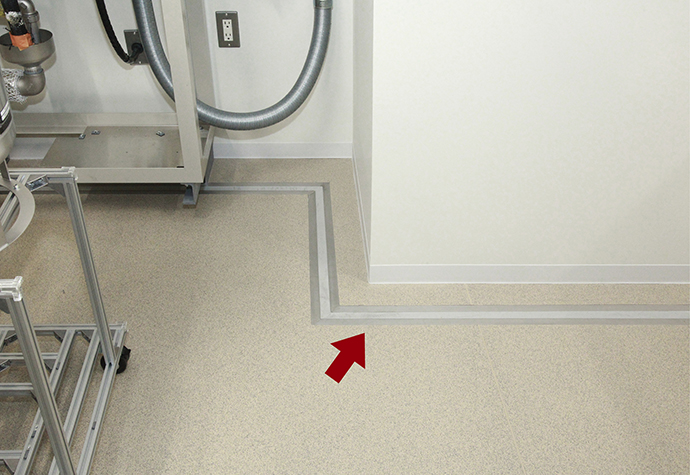
Foundation of the calibration lab is structurally separated from the skeleton of the new laboratory building, making it difficult for vibrations to be transmitted directly into the calibration lab. Silicone rubber is embedded in the gaps to ensure safety.
Aiming to create an ideal calibration environment by making full use of our unique air conditioning control technology
Maintaining constant temperature and humidity in the calibration environment is also an essential requirement. In this regard, the advanced know-how that Azbil has cultivated in the building air conditioning business is being utilized. Regarding temperature, based on the mechanism of central air conditioning, highly sensitive temperature sensors, which are not used in general building air conditioning, were placed in calibration rooms to achieve highly accurate temperature control. The fluctuation range of room temperature is kept within 0.3 °C.
Humidity is also controlled with high precision and without waste by appropriately humidifying the air passing through the chilled water coil to maintain a relative humidity of 50% in the calibration lab.
In calibration work that requires high accuracy, measured values are affected by airflow from the air outlet and changes in room pressure due to the opening and closing of doors. For this reason, we installed a cover with small holes over the air conditioner outlet to blow homogeneous air over a wide area within a calibration lab while maintaining the air volume. As for room pressure, we use Azbil’s Infilex™ VN venturi valve with airflow controller to maintain a balance between the amount of air coming into the room and the amount of air going out the room. Additionally, a front room was installed between the calibration lab and the outside, and an interlock*1 prevents the two doors from opening at the same time, preventing a sudden inflow of outside air. Also, the entrance and exit of the calibration lab are sliding doors that reduce pressure changes.
As mentioned above, the Measurement Standards Group has made various efforts since the construction of the new laboratory building, and by making full use of Azbil’s know-how, an ideal calibration environment has been created. We are confident that this will dramatically improve our capabilities and value as a calibration company. By creating an environment in which we can measure correctly, and leveraging our advanced and stable technological capabilities in measurement and control, we will contribute to the development of not only the azbil Group but also the wider industry, and deliver peace of mind.
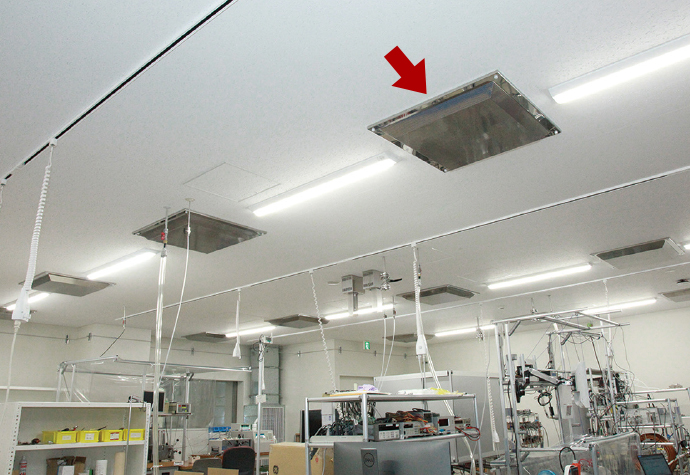
A cover (perforated metal) with small holes covering the entire surface is installed so that air from the air conditioner does not concentrate in a small area.
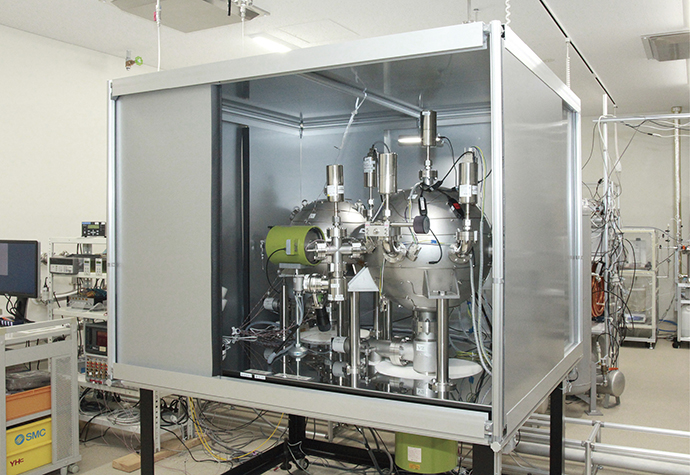
Corporation in Japan. Vacuum generator (expansion method device). Applying Boyle’s law, it generates a highly accurate vacuum of around 1 to 1000 Pa (1/100000 to 1/100 of atmospheric pressure). This standard device was developed by Azbil.
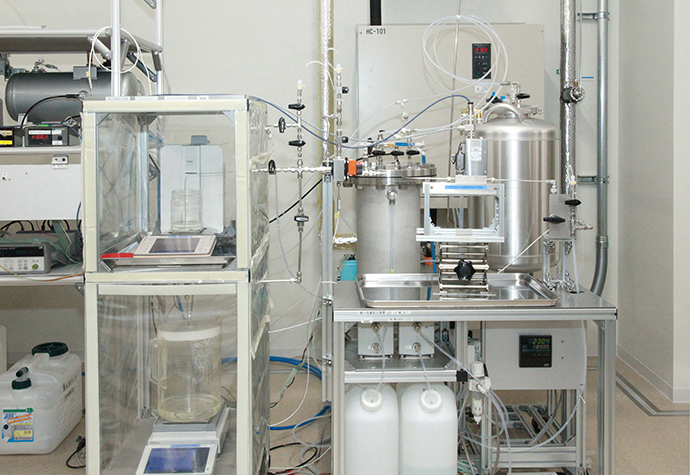
Micro liquid flow standard device. It measures weight and time with high accuracy, such as the minute flow rate of liquid (g/min) that would take 5 minutes to fill a teaspoon. This standard device was developed by Azbil.
*1 Interlock
Control so that a function is not enabled unless multiple conditions are met.
This article was translated from Japanese version.
This article was published on July 1, 2024.

